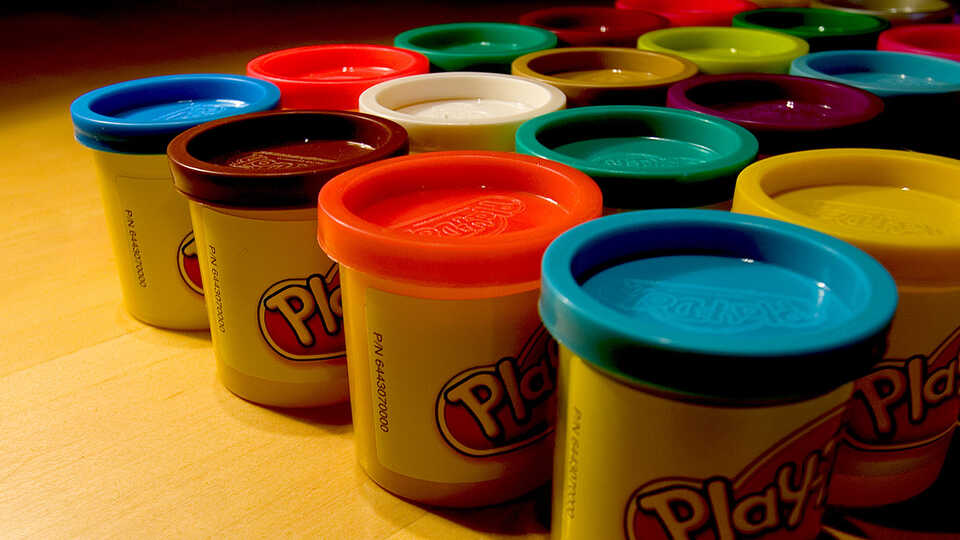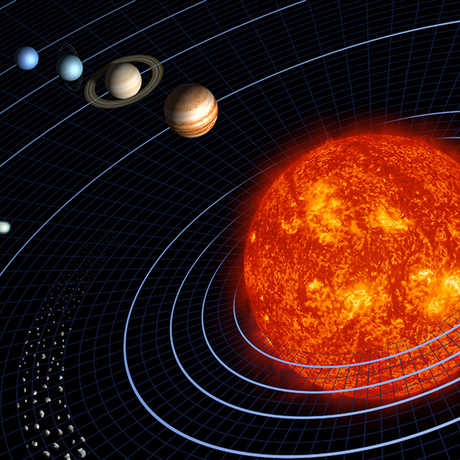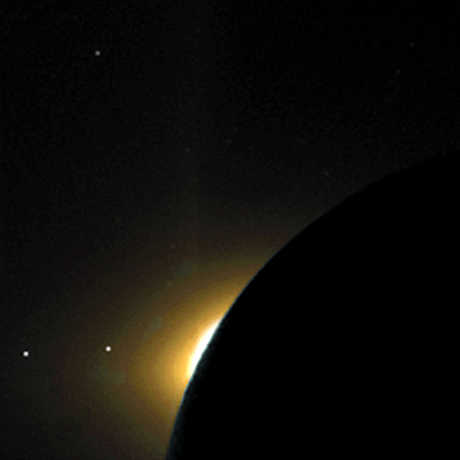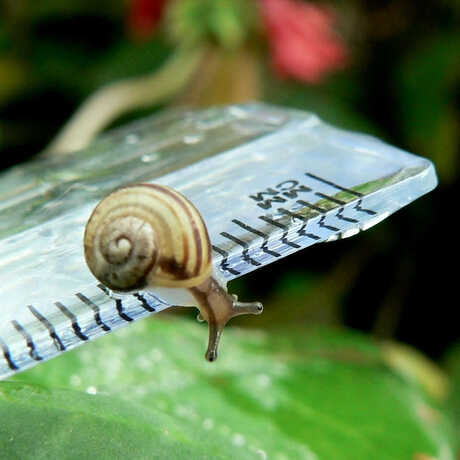
"Play-Doh" © 2006 Dennis Brekke
Do you know the relative sizes of the planets in our solar system? Put yourself to the test with some Play-doh. Size comparisons between planets can be surprisingly tricky. This activity allows students to model, in three dimensions, the relative sizes of the planets.
In this activity students will:
- visualize the relative volumes of the eight planets and the dwarf planet Pluto in the solar system.
- play-dough (three pounds per group)
- plastic knife (one per group)
- wax paper (one sheet per group)
- planet placemats (one set per group)
This activity works best if the worksheets with the planet names are placed side-by side on a table, and are arranged to match the order from the Sun. In front of these sheets place the instruction sheet and the play-dough and plastic knife on the breadboard (or equivalent).
Be sure there is enough room in front of the table for the group to work together. It is crucial to have the indicated amount of play-dough for each group. If there is less than three pounds, the Pluto piece will be too small to see! We recommend three pounds each and urge you to try the activity for yourself before leading it.
For any scale model activity, it is useful to start by exploring the notion of models. Playthings, such as dolls or toy cars, can be a useful reference for talking about scale models.
This activity is designed as a self-guided station activity. Nevertheless, if you choose to do so, it can also be a facilitated activity from the beginning. If you facilitate this activity from the start, begin by asking the participants which planet they think is the largest. For whatever planet they say is the largest (it will most likely be Jupiter), ask them the following question: If we could combine all the planets together into a big ball, what fraction of that ball would the largest planet be? Might it be 1/9 or 1/5, for example? Which is the smallest? Some may say Pluto, even though it is no longer defined as a major planet, but is a dwarf planet. For our purposes, that is fine. We’ve kept it in this activity and it will be dramatically demonstrated just how much smaller it is than the others. End the introduction by telling them they will get a better idea of these relative sizes or volumes after completing this activity.
Participants start by reading the instructions handout (copied below), but they should get into working with the play-dough as quickly as possible. They should follow the instructions as to how to divide up their play-dough, placing the parts in the proper planet boxes. Each time the play-dough is divided up and parts are combined to make a planet, be sure participants roll the combined parts around in their hands until the planet has a ball shape.
INSTRUCTIONS
1. Divide the Entire Ball of Play-dough into 10 Equal Parts
You may find it easiest to start by rolling the ball into one big hot dog shape.
- Combine 6 parts together and put them into the Jupiter box.
- Similarly combine 3 parts and put them into the Saturn box.
2. Cut the Remaining Part into 10 Equal Parts
- Take 5 parts and combine them with the ball in the Saturn box.
- Combine 2 parts to put into the Neptune box.
- Combine 2 parts to put into the Uranus box.
3. Cut the Remaining Part into 4 Equal Parts
- Take 3 parts and combine them with the ball in the Saturn box.
4. Cut the Remaining Part into 10 Equal Parts
- Put 2 parts into the Earth box.
- Put 2 parts into the Venus box.
- Take 4 parts and combine them with the ball in the Uranus box.
5. Combine the Remaining 2 Parts and Cut into 10 Equal Parts
- Put 1 part into the Mars box.
- Take 4 parts and combine them with the ball in the Neptune box.
- Take 4 parts and combine them with the ball in the Uranus box.
6. Cut the Remaining Part into 10 Equal Parts
- Put 7 parts into the Mercury box.
- Take 2 parts and combine them with the ball in the Uranus box.
7. Cut the Remaining Part into 10 Equal Parts
- Take 9 parts and combine them with the ball in the Uranus box.
- Put 1 part into the Pluto box.
Finally:
Now that you have divided the play-dough to represent the planets by volume, roll the pieces in each planet’s box into balls to best represent the shapes of the planets.
Start by asking the group about some of the discoveries they made regarding the sizes of the planets. Were there any surprises? Ultimately direct the discussion so that they realize the smaller planets (except the dwarf planet Pluto) are the inner planets, while the larger planets are the outer planets. You may also want to note that more than 96% of the combined volume of the planets is in Jupiter and Saturn (approximately 60% in Jupiter and 36% in Saturn). Those giant planets really ARE giants.
planet: in the solar system, a large round object that orbits the Sun and has cleared out most of the other objects in its orbit
dwarf planet: a large round object that orbits the Sun but is not the dominant object in its orbit.
solar system: the Sun and all of the planets, comets, etc. that revolve around it
Models and illustrations of the Solar System often misrepresent the true scales and distances involved. The difficulty lies in the vast difference between the relative sizes of these objects and the distance between them. For example, an accurate model using a 1” sphere to represent the Sun results in a distance to Pluto of over 350 feet (more than a football field away), and most of the planets would appear no larger than tiny specks.
It is usually beneficial to address these two dimensions separately, using one model to compare planet sizes and another to illustrate relative distances from the Sun. By combining this activity with the activity “Pocket Solar System”, teachers can address the misconceptions prevalent in our depictions of the Solar System.
Size comparisons between planets can be surprisingly tricky. For one, the four inner planets of the solar system are small and rocky, and have thin atmospheres (or no atmosphere at all). In contrast, the four outer planets are large and mostly composed of gas, with no visible surface except cloud tops. Right away, comparing these two kinds of planets raises questions in students’ minds – how can an object made of gas be classified the same as a solid one?
The term “planet” is an historical one, derived from the Greek term aster planets, or wandering star. It was given to these moving lights in the sky before their true nature was understood. It is only recently that astronomers have attempted to formalize a consistent meaning for the term planet, and it remains controversial. The definition given above reflects this most recent determination by the International Astronomical Union (in 2006). The planet’s composition does not come into play – only its spherical shape and position in the solar system matter.
To add to the confusion, many illustrations of the planets do not correctly represent their proper relative size, often showing the inner planets as much too large relative to the outer ones. To depict things correctly, for example, it would take 11 copies of Earth to stretch across the full diameter of Jupiter. And while this can be easily illustrated (we do it this way in our planetarium programs), it is still a 2-dimensional representation that does not fully capture the difference in volume between these objects.
This activity allows students to model, in three dimensions, the relative sizes of the planets.
Middle School
MS-ESS1-2: Develop and use a model to describe the role of gravity in the motions within galaxies and the solar system
MS-ESS1-3: Analyze and interpret data to determine scale properties of objects in the solar system
This lesson is adapted from an activity originally developed by Dennis Schatz, Pacific Science Center, and further adapted by Anna Hurst, Astronomical Society of the Pacific, 2008.
Image: "Play-Doh" by Dennis Brekke, licensed and modified under CC BY 2.0; originally sourced from https://www.flickr.com/photos/dbrekke/276119351


